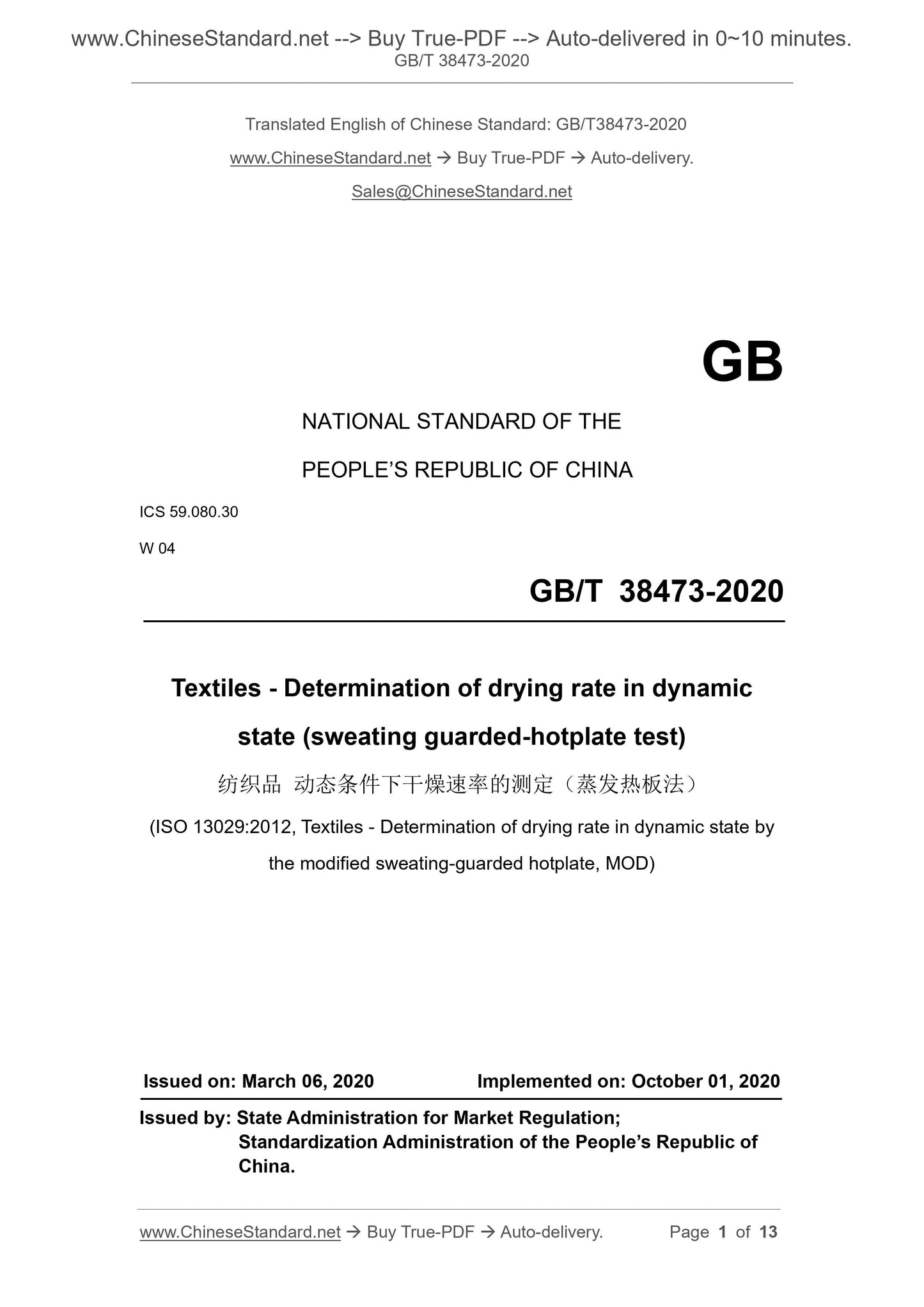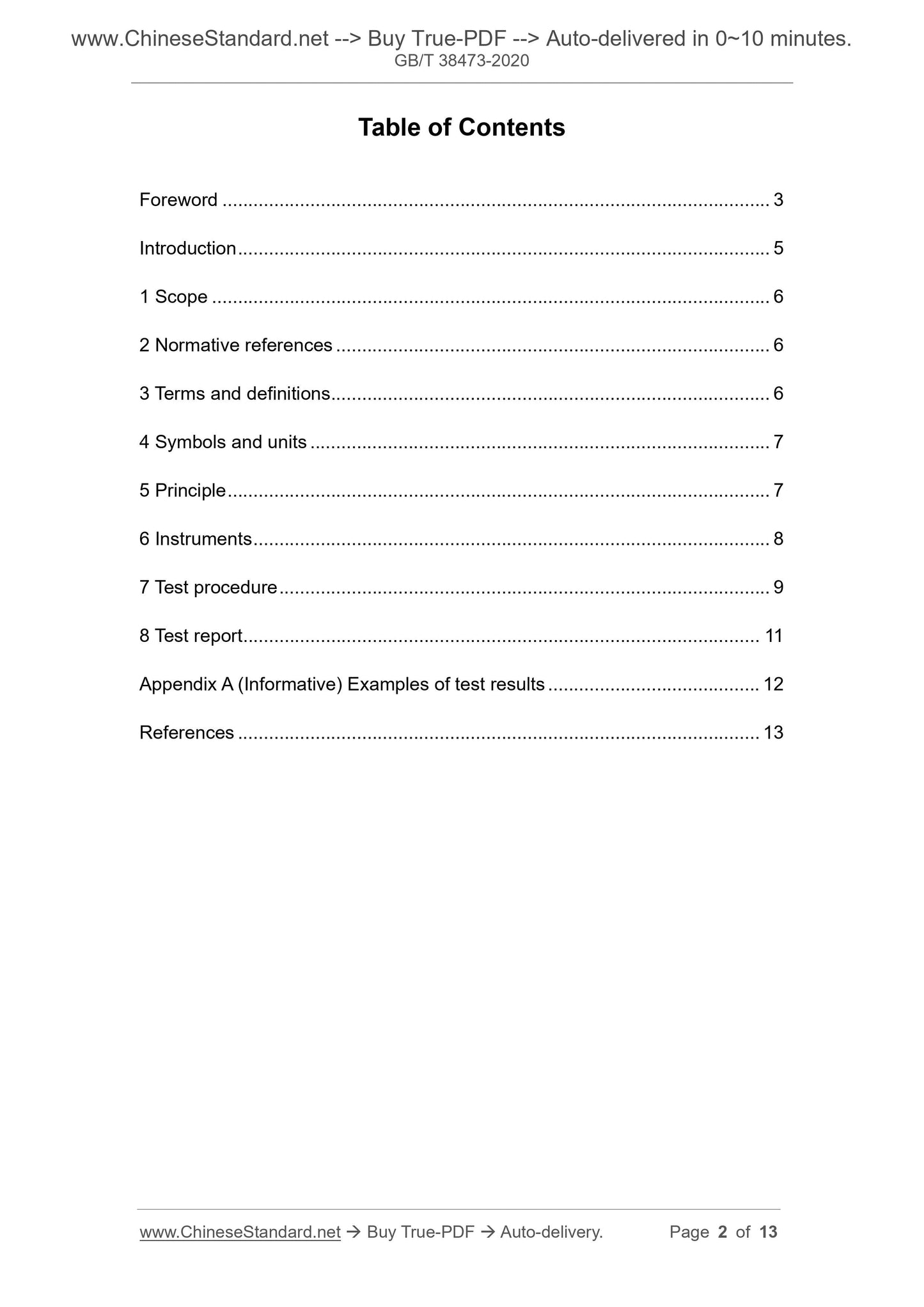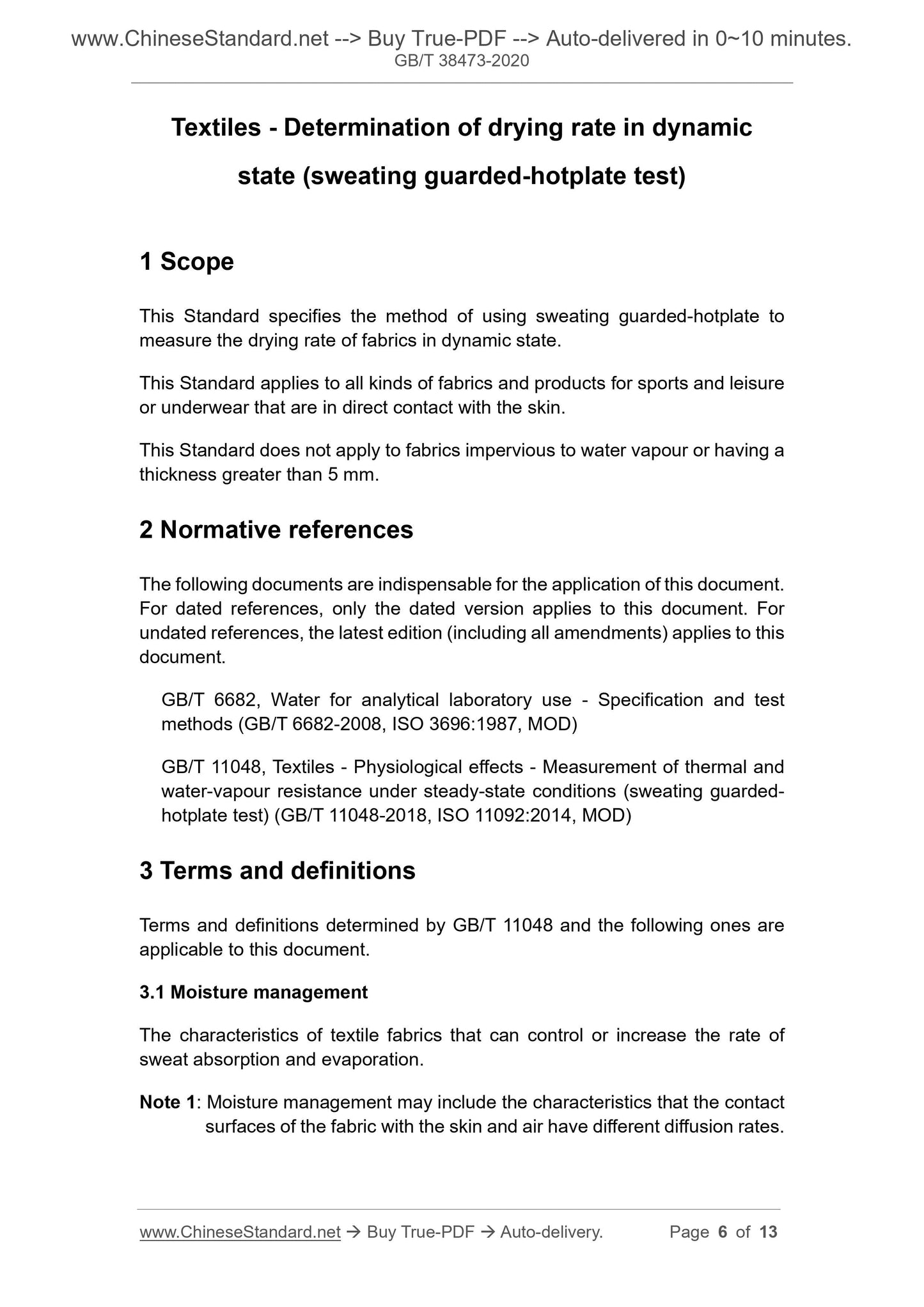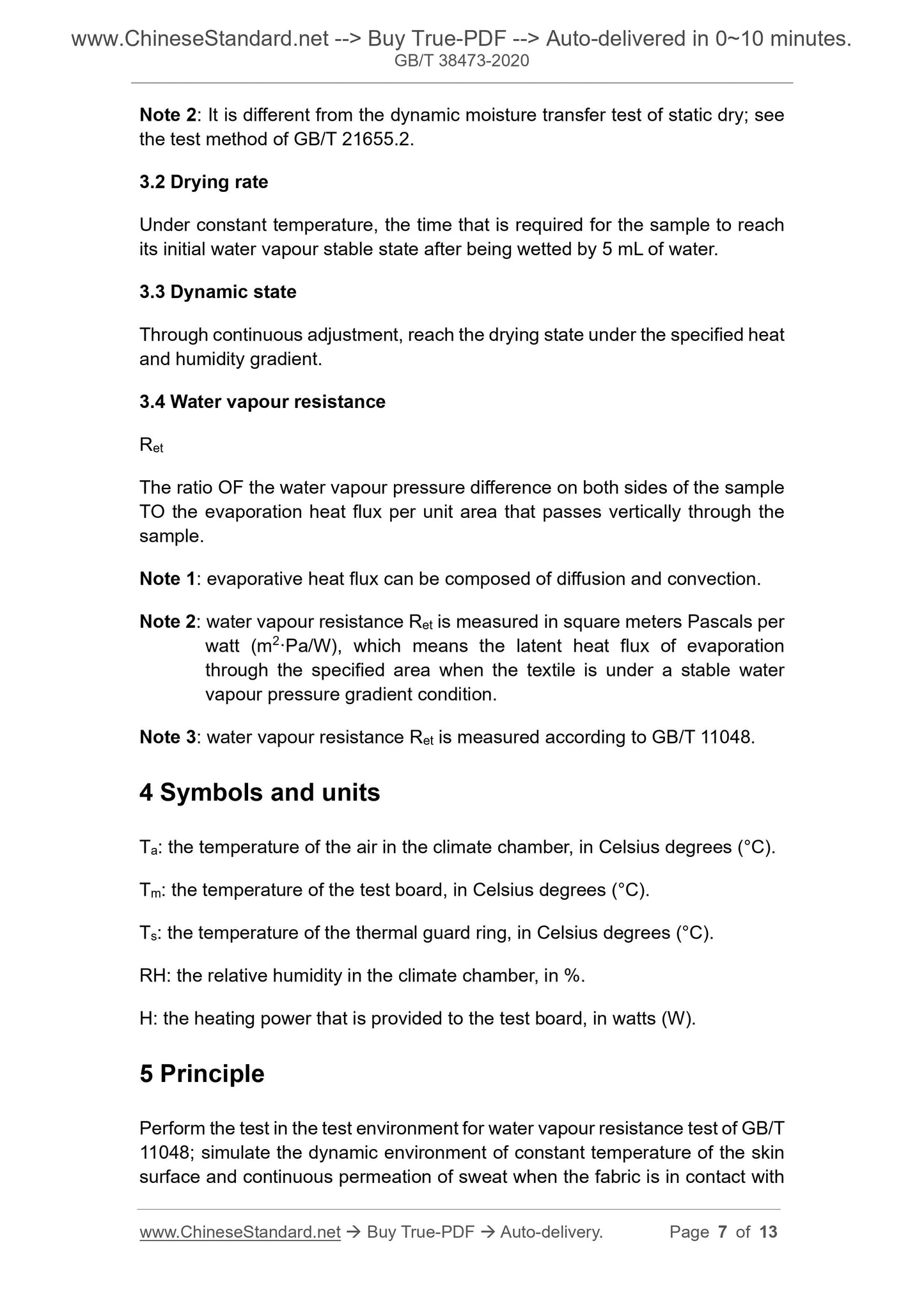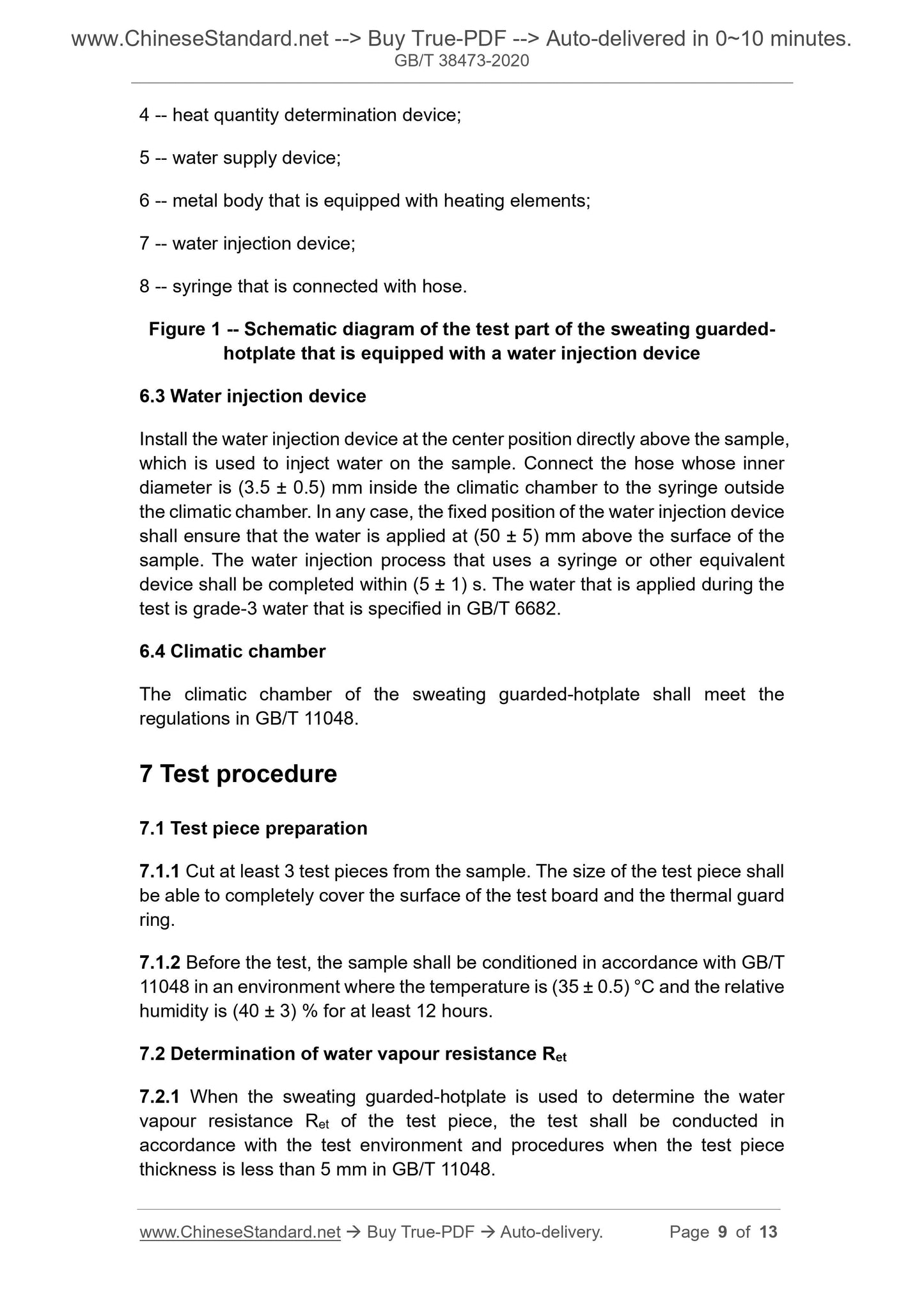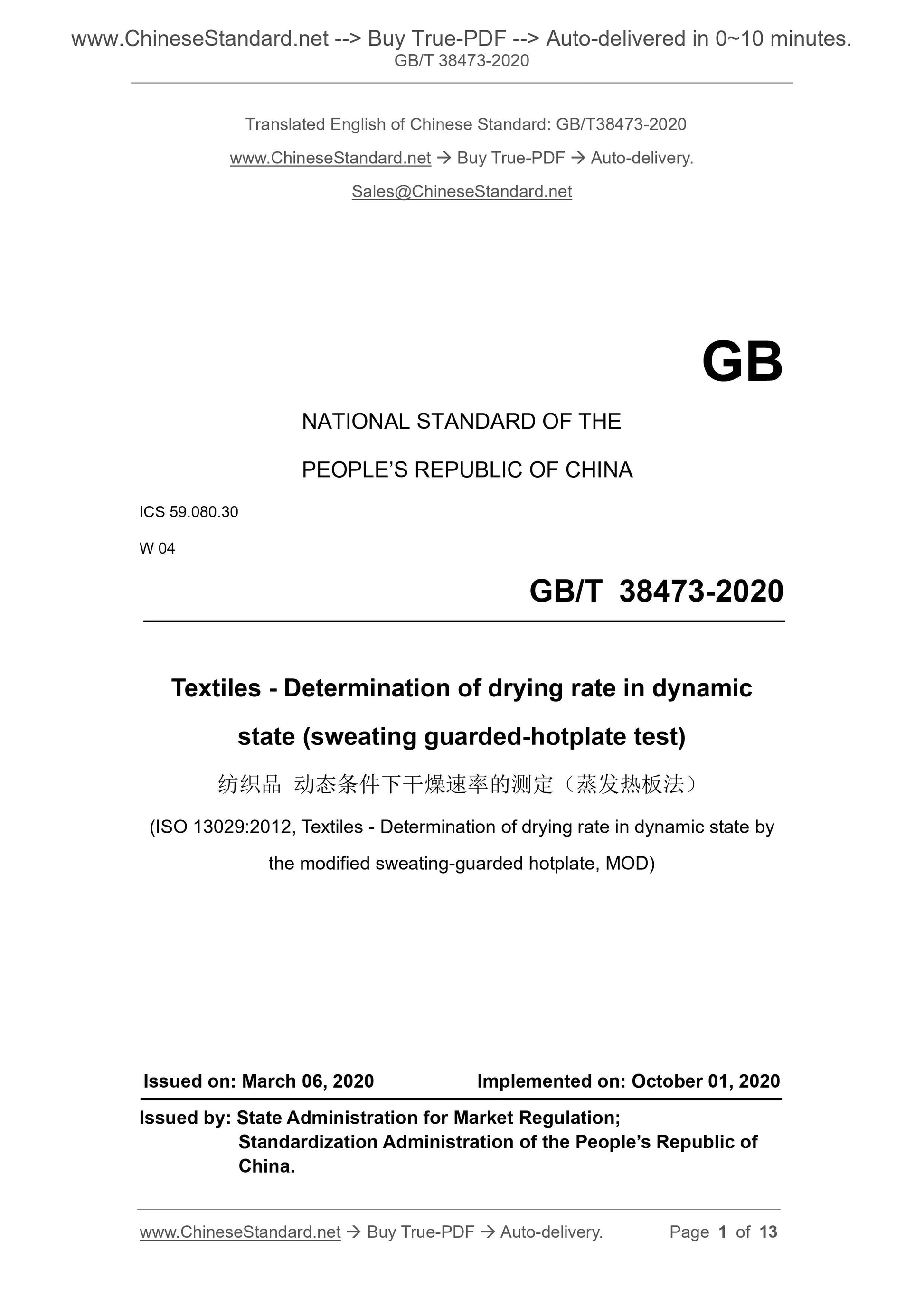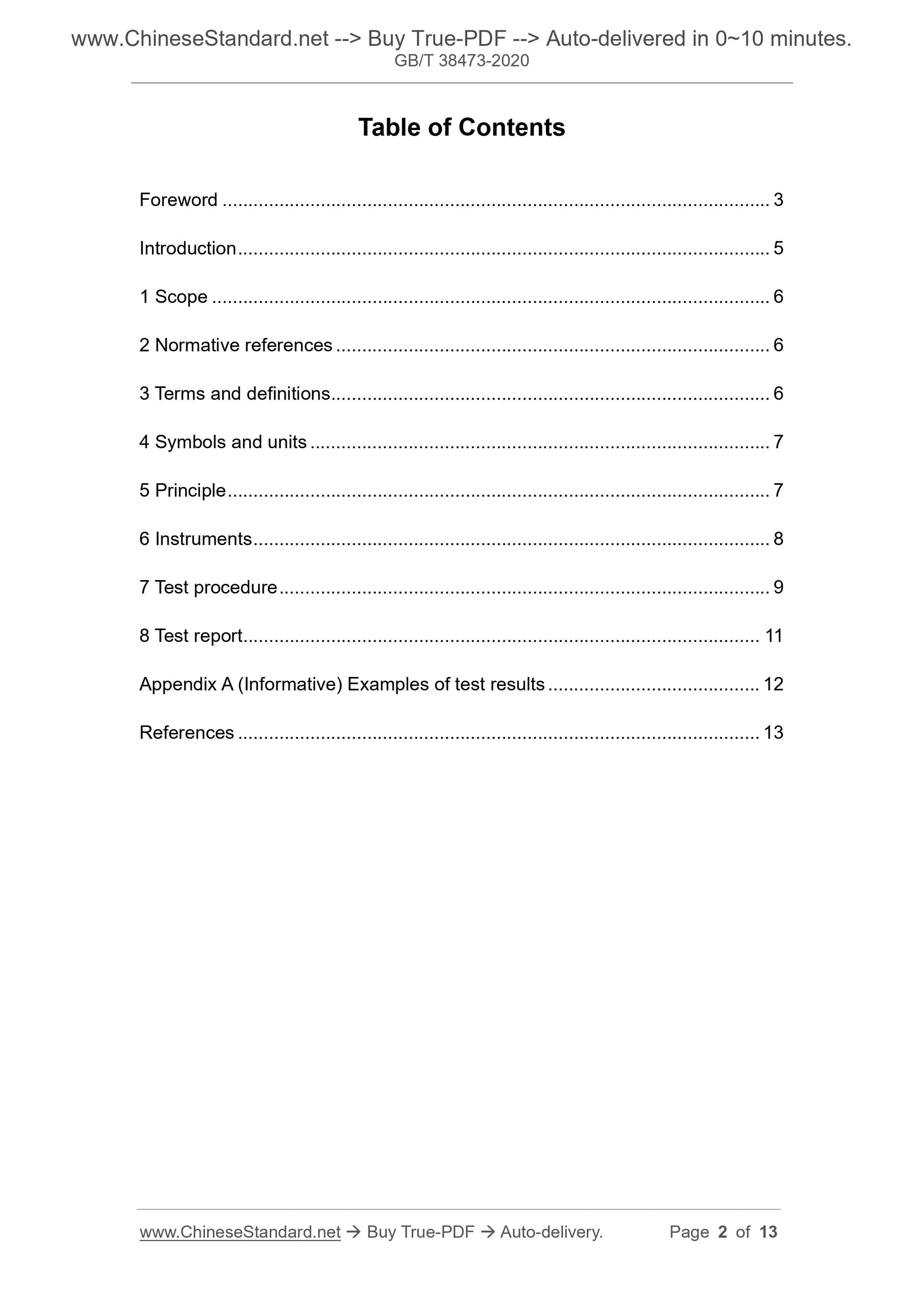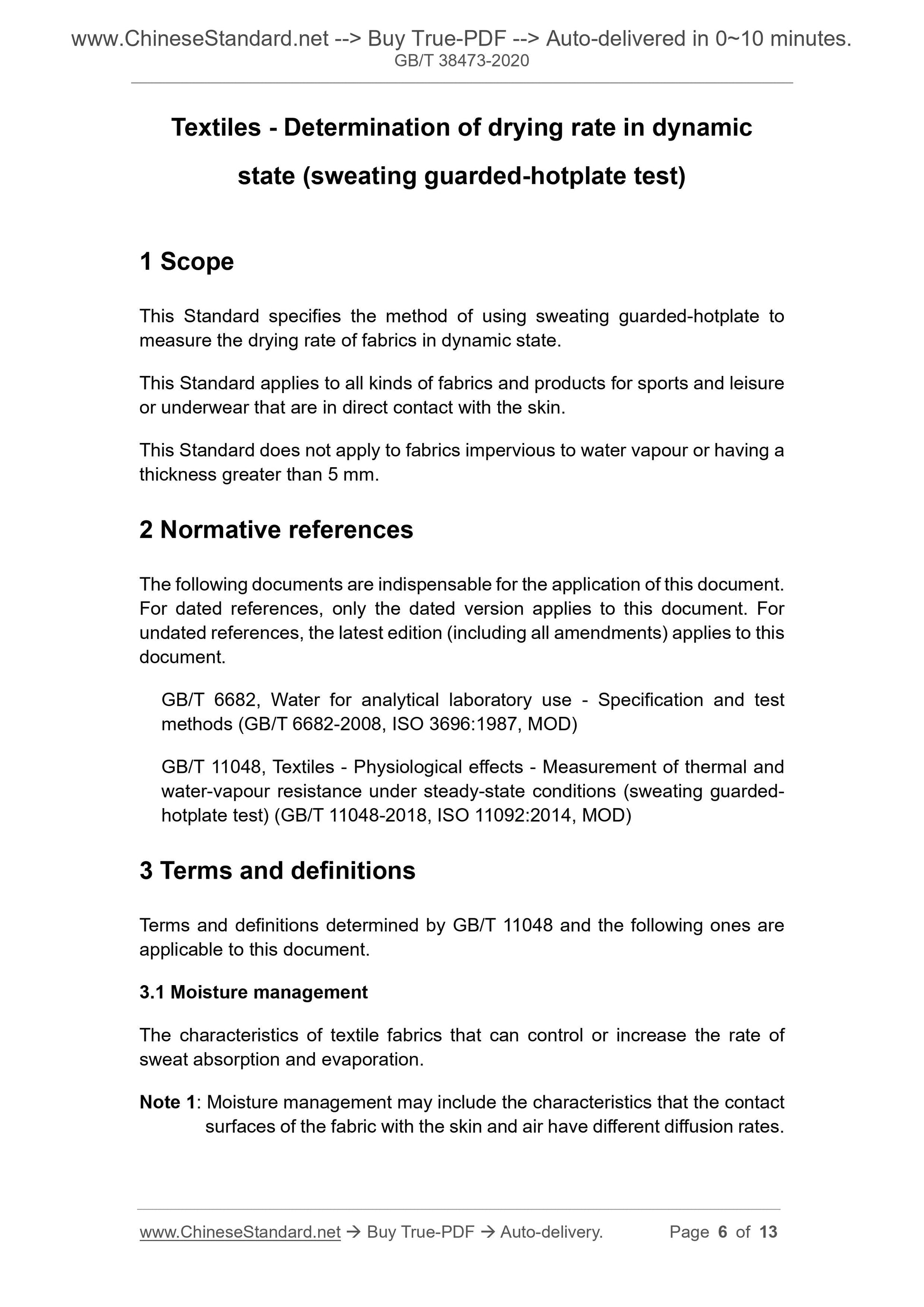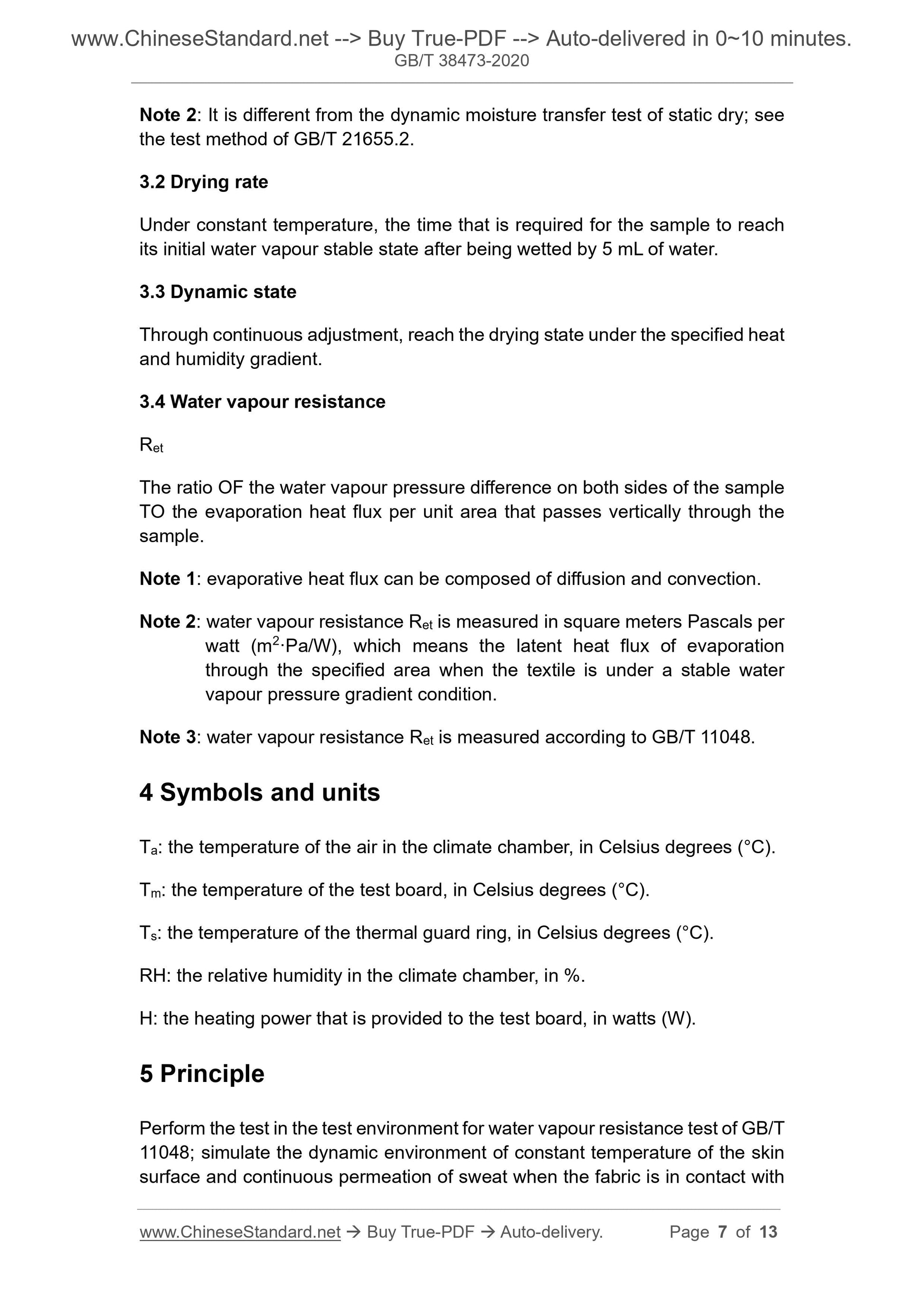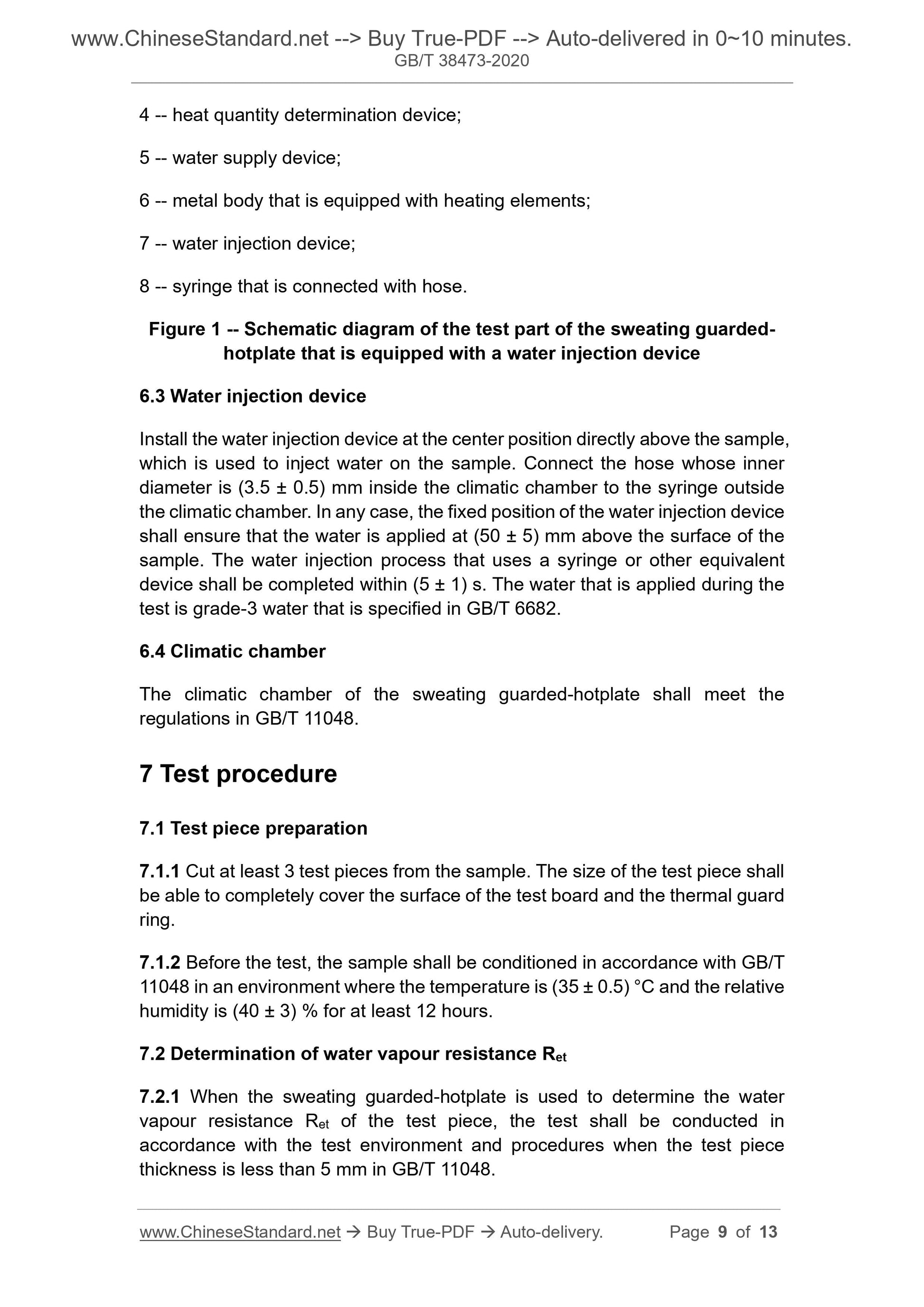1
/
of
5
PayPal, credit cards. Download editable-PDF and invoice in 1 second!
GB/T 38473-2020 English PDF (GB/T38473-2020)
GB/T 38473-2020 English PDF (GB/T38473-2020)
Regular price
$145.00 USD
Regular price
Sale price
$145.00 USD
Unit price
/
per
Shipping calculated at checkout.
Couldn't load pickup availability
Delivery: 3 seconds. Download true-PDF + Invoice.
Get QUOTATION in 1-minute: Click GB/T 38473-2020
Historical versions: GB/T 38473-2020
Preview True-PDF (Reload/Scroll if blank)
GB/T 38473-2020: Textiles -- Determination of drying rate in dynamic state (sweating guarded-hotplate test)
GB/T 38473-2020
NATIONAL STANDARD OF THE
PEOPLE’S REPUBLIC OF CHINA
ICS 59.080.30
W 04
Textiles - Determination of drying rate in dynamic
state (sweating guarded-hotplate test)
(ISO 13029:2012, Textiles - Determination of drying rate in dynamic state by
the modified sweating-guarded hotplate, MOD)
ISSUED ON: MARCH 06, 2020
IMPLEMENTED ON: OCTOBER 01, 2020
Issued by: State Administration for Market Regulation;
Standardization Administration of the People’s Republic of
China.
Table of Contents
Foreword ... 3
Introduction ... 5
1 Scope ... 6
2 Normative references ... 6
3 Terms and definitions ... 6
4 Symbols and units ... 7
5 Principle ... 7
6 Instruments ... 8
7 Test procedure ... 9
8 Test report ... 11
Appendix A (Informative) Examples of test results ... 12
References ... 13
Textiles - Determination of drying rate in dynamic
state (sweating guarded-hotplate test)
1 Scope
This Standard specifies the method of using sweating guarded-hotplate to
measure the drying rate of fabrics in dynamic state.
This Standard applies to all kinds of fabrics and products for sports and leisure
or underwear that are in direct contact with the skin.
This Standard does not apply to fabrics impervious to water vapour or having a
thickness greater than 5 mm.
2 Normative references
The following documents are indispensable for the application of this document.
For dated references, only the dated version applies to this document. For
undated references, the latest edition (including all amendments) applies to this
document.
GB/T 6682, Water for analytical laboratory use - Specification and test
methods (GB/T 6682-2008, ISO 3696:1987, MOD)
GB/T 11048, Textiles - Physiological effects - Measurement of thermal and
water-vapour resistance under steady-state conditions (sweating guarded-
hotplate test) (GB/T 11048-2018, ISO 11092:2014, MOD)
3 Terms and definitions
Terms and definitions determined by GB/T 11048 and the following ones are
applicable to this document.
3.1 Moisture management
The characteristics of textile fabrics that can control or increase the rate of
sweat absorption and evaporation.
Note 1: Moisture management may include the characteristics that the contact
surfaces of the fabric with the skin and air have different diffusion rates.
Note 2: It is different from the dynamic moisture transfer test of static dry; see
the test method of GB/T 21655.2.
3.2 Drying rate
Under constant temperature, the time that is required for the sample to reach
its initial water vapour stable state after being wetted by 5 mL of water.
3.3 Dynamic state
Through continuous adjustment, reach the drying state under the specified heat
and humidity gradient.
3.4 Water vapour resistance
Ret
The ratio OF the water vapour pressure difference on both sides of the sample
TO the evaporation heat flux per unit area that passes vertically through the
sample.
Note 1: evaporative heat flux can be composed of diffusion and convection.
Note 2: water vapour resistance Ret is measured in square meters Pascals per
watt (m2·Pa/W), which means the latent heat flux of evaporation
through the specified area when the textile is under a stable water
vapour pressure gradient condition.
Note 3: water vapour resistance Ret is measured according to GB/T 11048.
4 Symbols and units
Ta: the temperature of the air in the climate chamber, in Celsius degrees (°C).
Tm: the temperature of the test board, in Celsius degrees (°C).
Ts: the temperature of the thermal guard ring, in Celsius degrees (°C).
RH: the relative humidity in the climate chamber, in %.
H: the heating power that is provided to the test board, in watts (W).
5 Principle
Perform the test in the test environment for water vapour resistance test of GB/T
11048; simulate the dynamic environment of constant temperature of the skin
surface and continuous permeation of sweat when the fabric is in contact with
4 -- heat quantity determination device;
5 -- water supply device;
6 -- metal body that is equipped with heating elements;
7 -- water injection device;
8 -- syringe that is connected with hose.
Figure 1 -- Schematic diagram of the test part of the sweating guarded-
hotplate that is equipped with a water injection device
6.3 Water injection device
Install the water injection device at the center position directly above the sample,
which is used to inject water on the sample. Connect the hose whose inner
diameter is (3.5 ± 0.5) mm inside the climatic chamber to the syringe outside
the climatic chamber. In any case, the fixed position of the water injection device
shall ensure that the water is applied at (50 ± 5) mm above the surface of the
sample. The water injection process that uses a syringe or other equivalent
device shall be completed within (5 ± 1) s. The water that is applied during the
test is grade-3 water that is specified in GB/T 6682.
6.4 Climatic chamber
The climatic chamber of the sweating guarded-hotplate shall meet the
regulations in GB/T 11048.
7 Test procedure
7.1 Test piece preparation
7.1.1 Cut at least 3 test pieces from the sample. The size of the test piece shall
be able to completely cover the surface of the test board and the thermal guard
ring.
7.1.2 Before the test, the sample shall be conditioned in accordance with GB/T
11048 in an environment where the temperature is (35 ± 0.5) °C and the relative
humidity is (40 ± 3) % for at least 12 hours.
7.2 Determination of water vapour resistance Ret
7.2.1 When the sweating guarded-hotplate is used to determine the water
vapour resistance Ret of the test piece, the test shall be conducted in
accordance with the test environment and procedures when the test piece
thickness is less than 5 mm in GB/T 11048.
Get QUOTATION in 1-minute: Click GB/T 38473-2020
Historical versions: GB/T 38473-2020
Preview True-PDF (Reload/Scroll if blank)
GB/T 38473-2020: Textiles -- Determination of drying rate in dynamic state (sweating guarded-hotplate test)
GB/T 38473-2020
NATIONAL STANDARD OF THE
PEOPLE’S REPUBLIC OF CHINA
ICS 59.080.30
W 04
Textiles - Determination of drying rate in dynamic
state (sweating guarded-hotplate test)
(ISO 13029:2012, Textiles - Determination of drying rate in dynamic state by
the modified sweating-guarded hotplate, MOD)
ISSUED ON: MARCH 06, 2020
IMPLEMENTED ON: OCTOBER 01, 2020
Issued by: State Administration for Market Regulation;
Standardization Administration of the People’s Republic of
China.
Table of Contents
Foreword ... 3
Introduction ... 5
1 Scope ... 6
2 Normative references ... 6
3 Terms and definitions ... 6
4 Symbols and units ... 7
5 Principle ... 7
6 Instruments ... 8
7 Test procedure ... 9
8 Test report ... 11
Appendix A (Informative) Examples of test results ... 12
References ... 13
Textiles - Determination of drying rate in dynamic
state (sweating guarded-hotplate test)
1 Scope
This Standard specifies the method of using sweating guarded-hotplate to
measure the drying rate of fabrics in dynamic state.
This Standard applies to all kinds of fabrics and products for sports and leisure
or underwear that are in direct contact with the skin.
This Standard does not apply to fabrics impervious to water vapour or having a
thickness greater than 5 mm.
2 Normative references
The following documents are indispensable for the application of this document.
For dated references, only the dated version applies to this document. For
undated references, the latest edition (including all amendments) applies to this
document.
GB/T 6682, Water for analytical laboratory use - Specification and test
methods (GB/T 6682-2008, ISO 3696:1987, MOD)
GB/T 11048, Textiles - Physiological effects - Measurement of thermal and
water-vapour resistance under steady-state conditions (sweating guarded-
hotplate test) (GB/T 11048-2018, ISO 11092:2014, MOD)
3 Terms and definitions
Terms and definitions determined by GB/T 11048 and the following ones are
applicable to this document.
3.1 Moisture management
The characteristics of textile fabrics that can control or increase the rate of
sweat absorption and evaporation.
Note 1: Moisture management may include the characteristics that the contact
surfaces of the fabric with the skin and air have different diffusion rates.
Note 2: It is different from the dynamic moisture transfer test of static dry; see
the test method of GB/T 21655.2.
3.2 Drying rate
Under constant temperature, the time that is required for the sample to reach
its initial water vapour stable state after being wetted by 5 mL of water.
3.3 Dynamic state
Through continuous adjustment, reach the drying state under the specified heat
and humidity gradient.
3.4 Water vapour resistance
Ret
The ratio OF the water vapour pressure difference on both sides of the sample
TO the evaporation heat flux per unit area that passes vertically through the
sample.
Note 1: evaporative heat flux can be composed of diffusion and convection.
Note 2: water vapour resistance Ret is measured in square meters Pascals per
watt (m2·Pa/W), which means the latent heat flux of evaporation
through the specified area when the textile is under a stable water
vapour pressure gradient condition.
Note 3: water vapour resistance Ret is measured according to GB/T 11048.
4 Symbols and units
Ta: the temperature of the air in the climate chamber, in Celsius degrees (°C).
Tm: the temperature of the test board, in Celsius degrees (°C).
Ts: the temperature of the thermal guard ring, in Celsius degrees (°C).
RH: the relative humidity in the climate chamber, in %.
H: the heating power that is provided to the test board, in watts (W).
5 Principle
Perform the test in the test environment for water vapour resistance test of GB/T
11048; simulate the dynamic environment of constant temperature of the skin
surface and continuous permeation of sweat when the fabric is in contact with
4 -- heat quantity determination device;
5 -- water supply device;
6 -- metal body that is equipped with heating elements;
7 -- water injection device;
8 -- syringe that is connected with hose.
Figure 1 -- Schematic diagram of the test part of the sweating guarded-
hotplate that is equipped with a water injection device
6.3 Water injection device
Install the water injection device at the center position directly above the sample,
which is used to inject water on the sample. Connect the hose whose inner
diameter is (3.5 ± 0.5) mm inside the climatic chamber to the syringe outside
the climatic chamber. In any case, the fixed position of the water injection device
shall ensure that the water is applied at (50 ± 5) mm above the surface of the
sample. The water injection process that uses a syringe or other equivalent
device shall be completed within (5 ± 1) s. The water that is applied during the
test is grade-3 water that is specified in GB/T 6682.
6.4 Climatic chamber
The climatic chamber of the sweating guarded-hotplate shall meet the
regulations in GB/T 11048.
7 Test procedure
7.1 Test piece preparation
7.1.1 Cut at least 3 test pieces from the sample. The size of the test piece shall
be able to completely cover the surface of the test board and the thermal guard
ring.
7.1.2 Before the test, the sample shall be conditioned in accordance with GB/T
11048 in an environment where the temperature is (35 ± 0.5) °C and the relative
humidity is (40 ± 3) % for at least 12 hours.
7.2 Determination of water vapour resistance Ret
7.2.1 When the sweating guarded-hotplate is used to determine the water
vapour resistance Ret of the test piece, the test shall be conducted in
accordance with the test environment and procedures when the test piece
thickness is less than 5 mm in GB/T 11048.
Share
